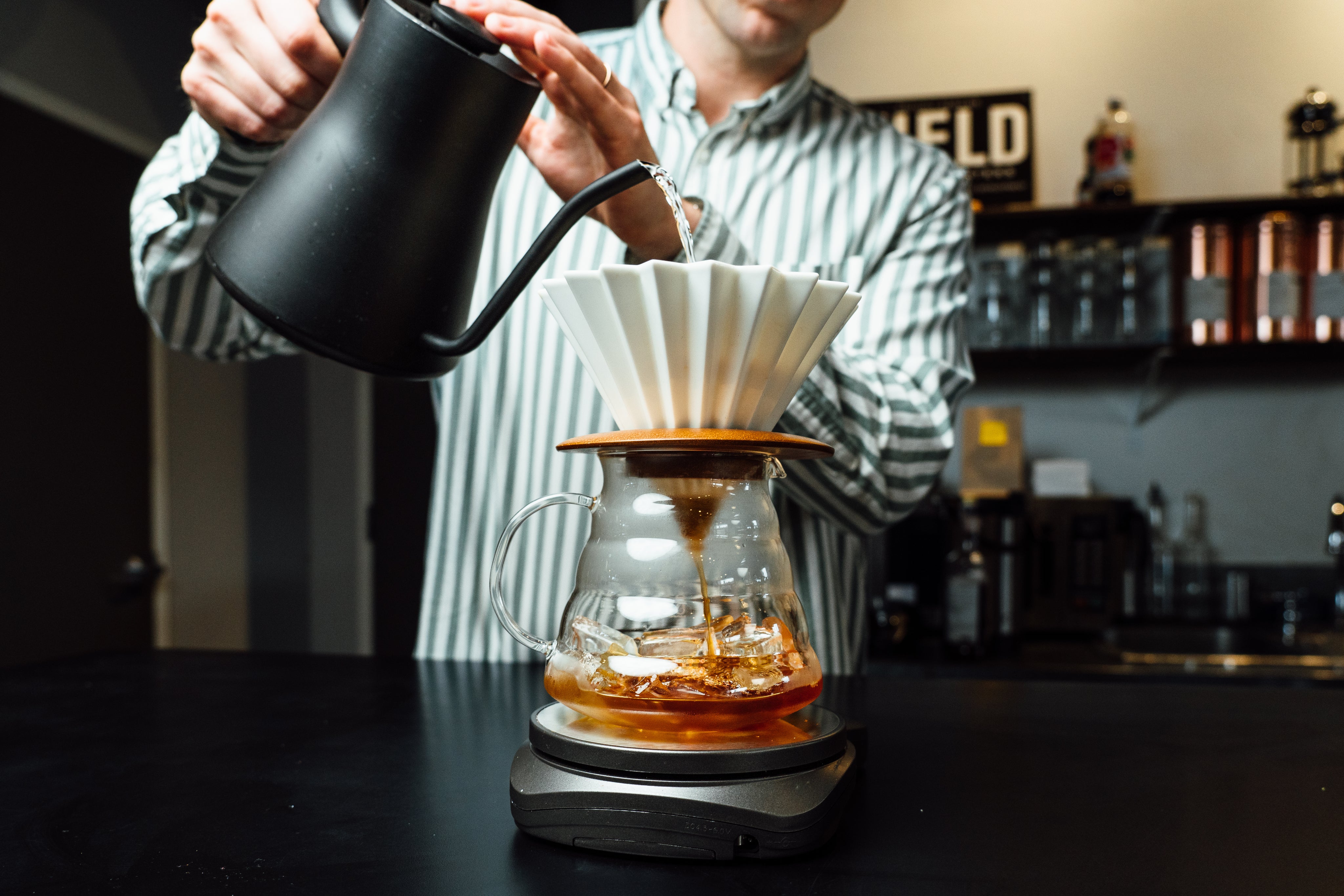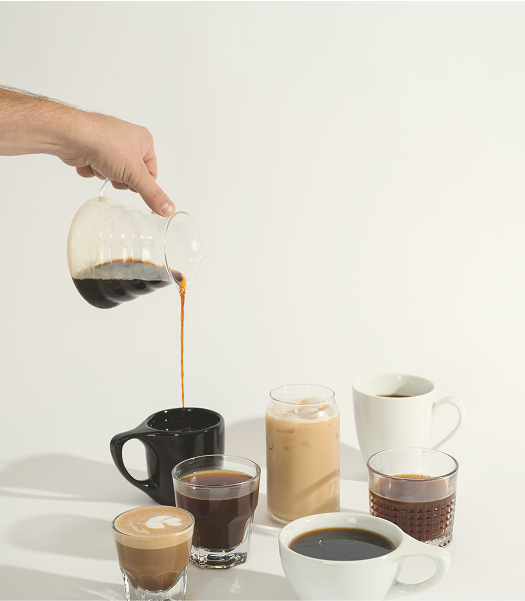Free Shipping on Orders Over $50

In the first part of this series, we explored the 'why' behind your coffee shop dream. Now, it's time to turn that dream into a tangible and well-defined plan. A well-crafted business plan is your roadmap. It's a document that demonstrates your preparedness to potential investors, helps refine your vision, and serves as a valuable guide as your coffee shop takes shape. While it may seem daunting, let's break down those key sections step-by-step and create a plan that reflects both your passion and a clear-headed strategy.
Key Sections of a Coffee Shop Business Plan
Executive Summary
Picture this as your elevator pitch to a potential investor. In a single impactful paragraph convey:
- Your coffee shop's unique concept. Whether it's ethically sourced coffee, in-house baking, a minimalist space, hosting community events, an extensive menu, or a grab-and-go concept.
- Your target market. Who will you serve?
- What sets you apart? In the competitive coffee landscape, why will your target market choose you over your direct and indirect competitors?
- Your target timeline and milestones
- Brief financial projections. Why should someone invest? Include timelines, startup costs, and revenue projections for the first 1-3 years.
Example:
"[Business Name] will be the go-to for ethically sourced, single-origin coffee and freshly baked treats in the heart of [location]. Designed as a social and productive hub for the area's young professionals and remote workers, we offer a curated coffee experience, ample workspaces, and cozy seating areas that foster community. Unlike chain cafes or quick-serve spots, we prioritize quality and connection. We're seeking $100,000 for equipment, leasehold improvements, and launch, with a projected $250,000 in revenue by the end of year one and plans for a second location by year three."
Company Description
This is where you expand on your big idea and paint a picture of what you’re building.
The 'Why'
Briefly touch on the inspiration behind your coffee shop. Is it about crafting a community, a lifelong passion for coffee excellence, or creating a space you wish existed in your neighborhood?
Example:
"I spent years traveling, falling in love with the cafe culture of vibrant cities. With [Business Name], I'm bringing that sense of discovery and connection back home, creating a space unlike any other in [location]."
Vision
A vision statement should typically express your long-term aspirations and why your business exists on a broader level. Where do you see your coffee shop in five years?
Example:
"In five years, [Business Name] isn't just a thriving business; it's the heart of [neighborhood]. We're where artists showcase their work, neighbors launch new ventures, and every guest leaves feeling like they belong."
Mission
This includes your purpose, your approach, and your differentiator.
- To create a sense of belonging and connection through coffee.
- Focus on a welcoming atmosphere and high-quality coffee experiences.
- Emphasize inclusivity and the focus on coffee as a way to foster community.
Example:
"To inspire meaningful connections by providing an inclusive space, exceptional coffee experiences, and a genuine passion for our community."
Values
What matters most to you? List 3-4 core values that will shape every decision you make.
- Uncompromising quality?
- Sustainability?
- Building community?
- Supporting local businesses?
Example:
- People First
- Exceptional Experiences
- Community Driven

The Customer Experience
Think about the full customer journey from the moment a customer walks in the door until they leave your shop. Outline the details that will keep them coming back.
- Friendly greetings and knowledgeable baristas set the tone. Whether you're a regular or a first-timer, you'll feel valued.
- Train staff to remember repeat customers' names and their usual order.
- A curated retail corner showcasing local makers adds a unique touch.
- A selection of non-dairy milks, house-made syrups, and vegan/gluten-free options show you care about all customers.
- Invest in quality mugs for in-house drinks and beautiful branded to-go cups.
- Use mobile ordering for the on-the-go crowd. A seamless app experience can be a deciding factor.
Example:
"Our coffee shop creates a personalized experience where you feel genuinely valued, fostering a sense of belonging through thoughtful touches, knowledgeable staff who ease any anxieties, and a focus on quality in every detail."
Atmosphere
Describe the feeling you want customers to have. What kind of environment will make your target demographic feel welcome and want to stay? This is your guiding principle.
- People form a subconscious opinion within seconds. Make it positive!
- Your neighborhood will influence the vibe, whether it's a historic district or a hip new development.
- From decor choices to your social media aesthetic, the atmosphere should be cohesive.
- Artwork, custom mugs, and even your bathroom design are part of the experience. These details help tell your story.
- Seating needs to accommodate laptops, groups, and solo guests. Functionality matters.
- Adjust music and lighting for morning rush vs. slower afternoons. Your atmosphere should evolve with the day.
Example:
"Think clean lines, natural wood tones, and abundant sunlight. A minimalist backdrop with bursts of color from local artwork creates a space that feels both energizing and calming."
Market Analysis
In-depth customer understanding isn't just theory – it translates directly to business success. By tailoring your offerings to solve real problems, you’ll drive repeat visits, word-of-mouth buzz, and long-term profitability.
The Ideal Customer
Clearly define the primary customer groups you intend to attract. This ensures all further decisions (menu, atmosphere, marketing) align to serve these specific people. Use a mix of demographics (age, income, lifestyle) and psychographics (coffee enthusiasts, remote workers). Avoid being too broad; focus on 2-3 core groups.
Examples:
- Young Professionals: Drawn to our quality coffee, free Wi-Fi, and comfortable yet stylish atmosphere conducive to focused work or small meetings.
- Active Families: Seeking a weekend gathering spot. Our kid-friendly corner, quality pastries, and children-friendly menu appeal to both parents and children.
- Coffee Enthusiasts: Our commitment to ethically sourced, small-batch roasted beans and diverse brewing methods will attract those seeking a more elevated coffee experience.
Example:
"Our ideal customer is the young urban professional seeking a coffee shop that provides both quality and atmosphere conducive to focused work or small meetings."
The Ideal Customer Problems to Solve
A deep understanding of your ideal customer and the specific needs they have is the foundation for your success. Here's how to address key pain points in the coffee market:
-
Problem 1: Impersonal Service: Many coffee shops prioritize speed and efficiency over genuine connection.
Solution: Personalized experiences (name recognition, curated recommendations) cultivate loyalty and word-of-mouth. -
Problem 2: Limited Dietary Options: Customers with dietary restrictions often feel excluded.
Solution: Robust non-dairy selections, clearly labeled menu items, and knowledgeable staff create a welcoming space for all. -
Problem 3: Lack of Comfortable Workspace: Freelancers and remote workers desire a coffee shop that's more than just a grab-and-go spot.
Solution: Ample seating, reliable Wi-Fi, and curated playlists cater to their productivity needs while fostering a sense of community.
Competitor Analysis
Identify both direct (other coffee shops) and indirect (places serving similar needs) competitors. Critically analyze their strengths and weaknesses to uncover opportunities where you can leverage your strengths and differentiate your shop.
- Competitor 1: Strengths: location, established customer base. Weaknesses: limited seating, generic coffee offerings.
- Competitor 2: Strengths: drive-thru focus, speed of service. Weaknesses: impersonal experience, primarily chain-brand coffee.
- Competitor 3: Strengths: cozy atmosphere, focus on pastries. Weaknesses: high prices, lack of diverse drink options.
Example:
"Our closest competitor offers a cozy atmosphere but lacks diverse drink options, catering primarily to a crowd seeking basic coffee and pastries."
Your Competitive Advantage
Your competitive advantage is the heart of your strategy. Articulate what makes you truly different and why customers will choose you over the competition. Think beyond features (drink variety, etc.). Can you offer a unique experience, community focus, or ethical sourcing that can't be easily copied?
- We're not just serving coffee; we're building a hub. Events, partnerships with local makers, and a genuinely inclusive atmosphere foster belonging in a way our competitors don't.
- Our baristas craft impeccably made drinks, from approachable classics to innovative specials, thoughtfully paired with a curated food menu. We elevate the experience without ever being intimidating.
- Our design balances stylish and inviting, offering diverse seating options for work, socializing, or solo relaxation. This combats the "get it and go" mentality common elsewhere.
- We have a huge selection of dairy-free and vegan options.
- We have breakfast and lunch options to cater to business professionals that are always on the go.
Example:
"We will stand out by fostering a sense of community through events, local collaborations, and a welcoming space that encourages customers to linger and connect."
Coffee Industry Stats
The U.S. coffee market is massive, with 400 million cups consumed daily and 79% of drinkers enjoying it as part of their routine. This enduring popularity positions coffee shops as a lucrative sector, with a 7% annual growth rate and a market projection of $237.6 billion by 2025. These figures underscore the significant potential for a well-positioned coffee shop to thrive.
Global Picture
The global coffee market continues to expand, with projections indicating steady growth for the foreseeable future. Consumers increasingly demand high-quality, ethically sourced coffee, creating opportunities for specialty coffee shops. The global shift towards remote work and a flexible lifestyle is also increasing coffee consumption outside traditional cafes.
Example:
"With 79% of coffee drinkers in the U.S. enjoying it as part of their routine and a projected market value of $237.6 billion by 2025, the coffee industry presents a lucrative opportunity for a well-positioned coffee shop."
Market Trends
Understanding current market trends is critical to ensure your business stays relevant and can adapt to changing consumer preferences. Here are some key trends to consider:
- Sustainability and Ethical Sourcing: Consumers are increasingly concerned with where their coffee comes from and its environmental impact. Highlight your commitment to sourcing ethically and supporting sustainable practices.
- Health and Wellness: The rise of health-conscious consumers means there’s growing demand for options like plant-based milks, organic ingredients, and low-sugar alternatives.
- Technological Integration: Technology is transforming the coffee shop experience. From mobile ordering to loyalty apps, integrating technology can streamline operations and enhance customer convenience.
- Unique Coffee Experiences: Consumers are seeking unique and personalized coffee experiences, from specialty brews to Instagram-worthy presentations.
- Local and Community Focus: There’s a growing trend towards supporting local businesses and fostering community connections. Emphasize your local roots and community involvement.

Operations
Operations is the backbone of your coffee shop. It’s about ensuring that your business runs smoothly, efficiently, and consistently. This section should cover your daily operations, supply chain management, staffing, and technology integration.
Daily Operations
Outline the typical day-to-day activities of your coffee shop. This includes opening and closing procedures, order management, and customer service protocols.
Example:
- Opening Procedures: Baristas arrive an hour before opening to set up equipment, prepare baked goods, and ensure the shop is clean and inviting.
- Order Management: Use a POS system to streamline orders and track inventory in real-time.
- Customer Service Protocols: Train staff to provide exceptional service, from greeting customers warmly to remembering regulars' preferences.
Supply Chain Management
Detail how you will source your coffee beans, milk, pastries, and other supplies. Highlight any partnerships with local vendors or ethical suppliers.
Example:
- Coffee: Source from a local roaster who practices ethical and sustainable farming.
- Milk and Dairy Alternatives: Partner with a local dairy farm and suppliers of high-quality plant-based milks.
- Pastries and Baked Goods: Work with a local bakery to supply fresh, daily-baked goods.
Staffing
Describe your staffing plan, including the roles you need to fill, the number of employees, and your approach to hiring and training.
Example:
- Roles Needed: Baristas, shift supervisors, kitchen staff, and a manager.
- Number of Employees: Start with a team of 4-6 employees, scaling up as business grows.
- Hiring and Training: Hire individuals passionate about coffee and customer service. Implement a comprehensive training program to ensure consistency and quality.
Technology Integration
Leverage technology to streamline operations and enhance customer experience.
Example:
- POS System: Use a robust POS system to manage orders, track sales, and analyze customer data.
- Mobile Ordering: Implement a mobile app for pre-orders and contactless payments.
- Loyalty Program: Introduce a loyalty program to reward repeat customers and encourage frequent visits.
Marketing
Marketing is crucial to attract and retain customers. Your marketing plan should outline your strategies for reaching your target audience, building brand awareness, and driving sales.
Brand Identity
Define your brand identity, including your logo, color scheme, and overall aesthetic. Ensure consistency across all marketing materials.
Example:
"Our brand is modern, welcoming, and community-focused. Our logo features clean lines and natural colors, reflecting our commitment to quality and sustainability."
Marketing Channels
Identify the channels you will use to reach your target audience. This may include social media, email marketing, local partnerships, and events.
Example:
- Social Media: Use Instagram and Facebook to showcase our coffee, highlight events, and engage with customers.
- Email Marketing: Send weekly newsletters with updates, promotions, and coffee tips.
- Local Partnerships: Collaborate with local businesses and influencers to increase brand visibility.
- Events: Host coffee tastings, art shows, and community gatherings to attract customers and build community.
Promotions and Loyalty Programs
Develop promotions and loyalty programs to incentivize repeat business and attract new customers.
Example:
- Grand Opening Promotion: Offer a free coffee with every purchase during the first week.
- Loyalty Program: Implement a rewards program where customers earn points for each purchase, redeemable for free drinks or merchandise.
- Seasonal Promotions: Introduce limited-time offers and seasonal specials to keep the menu exciting.
Advertising
Allocate a budget for online and offline advertising to reach a broader audience.
Example:
- Online Ads: Invest in targeted ads on social media platforms and Google to reach potential customers in the area.
- Offline Ads: Distribute flyers and posters in the neighborhood, and place ads in local newspapers and magazines.
Financial Plan
Your financial plan is a critical component of your business plan. It demonstrates your understanding of the financial aspects of running a coffee shop and shows potential investors that you have a clear path to profitability.
Startup Costs
List your startup costs, including equipment, leasehold improvements, initial inventory, and marketing expenses.
Example:
- Equipment: $50,000 (espresso machines, grinders, refrigerators, etc.)
- Leasehold Improvements: $40,000 (renovations, decor, furniture)
- Initial Inventory: $10,000 (coffee beans, milk, pastries, supplies)
- Marketing: $10,000 (grand opening promotions, advertising)
Revenue Projections
Provide revenue projections for the first 1-3 years, including assumptions about customer volume, average transaction value, and seasonal fluctuations.
Example:
- Year 1: $250,000 in revenue, assuming 100 transactions per day at an average of $6 each.
- Year 2: $325,000 in revenue, with increased customer volume and higher average transaction value.
- Year 3: $375,000 in revenue, driven by brand recognition and loyalty program success.
Expenses
Detail your ongoing expenses, including rent, salaries, utilities, supplies, and marketing.
Example:
- Rent: $3,000 per month
- Salaries: $8,000 per month
- Utilities: $500 per month
- Supplies: $2,000 per month
- Marketing: $1,000 per month
Profit and Loss Statement
Create a projected profit and loss statement to show your anticipated profitability over the first 3 years.
Example:
- Year 1: $250,000 in revenue - $220,000 in expenses = $30,000 profit
- Year 2: $325,000 in revenue - $280,000 in expenses = $45,000 profit
- Year 3: $375,000 in revenue - $315,000 in expenses = $60,000 profit
Break Even Analysis
Calculate your break even point to determine how long it will take to cover your initial investment and start making a profit.
Example:
- Startup Costs: $95,000
- Monthly Revenue: $20,000
- Monthly Expenses: $15,500
- Break Even Point: $95,000 / ($20,000 - $15,500) ≈ 19 months
Conclusion
A comprehensive business plan is more than just a formality; it’s a strategic tool to guide your coffee shop’s success. By thoroughly understanding your market, refining your unique offering, and creating an experience that resonates with your target customers, you're setting the stage for a thriving, beloved coffee shop. Stay tuned for the next part of this series, where we’ll dive deeper into financial planning and projections.
Ready to elevate your business with exceptional coffee? If you're looking to partner with a roaster who values quality, sustainability, and community, we invite you to explore our wholesale program. Visit our wholesale page to learn more about our offerings and how we can help your business thrive. Let's brew success together!





